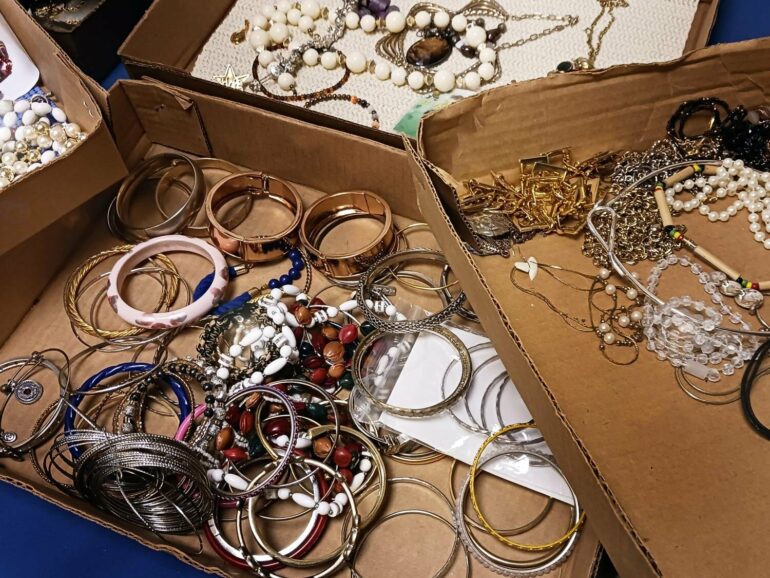One person’s trash may well be another’s “come up,” or what the rapper Macklemore calls hidden treasures in the song “Thrift Shop,” but only if secondhand shoppers follow the rapper’s lead and dig through what are sometimes messy bins. New research from Penn State and Texas Christian University shows that shoppers looking to “pop some tags” may be drawn to disordered thrift shop displays because they signal hidden treasure in their inventory.
“Secondhand markets are growing in popularity, especially among younger people,” said Lisa Bolton, professor of marketing and Anchel Professor of Business Administration at Penn State. “We found that disorder in these markets increases consumer perceptions of risk but also the possibility of finding hidden treasure.”
These perceptions work against each other, meaning that risk—such as concerns about product quality or wasted time and effort—decreases purchase likelihood while hidden treasure perceptions increase purchase likelihood, according to the researchers.
“We wanted to see what sellers can do to dampen risk perceptions and increase perceptions of finding hidden treasure,” Bolton said. “Just because shoppers enter a messy store doesn’t mean they should walk away. There could be good deals to find.”
The researchers conducted four separate studies to determine how disorder in brick-and-mortar secondhand retail locations affects consumer behavior and what retailers can do to encourage purchase likelihood.
“Unfortunately, we were in the middle of a global pandemic, so going out to secondhand stores to talk to consumers directly was not an option,” said Bolton.
Instead, the researchers went online and asked participants—most of whom reported having experience shopping in secondhand retail stores—to view images of ordered or disordered retail displays. They were asked to value the products and rate their likelihood of making a purchase under different scenarios. Scenarios included going to a thrift store to casually browse items versus going with the intent to buy a specific item, shopping at a store that offered a clear return policy, and shopping at a store where the retailer demonstrated low to high inventory knowledge.
The research team found that disorder in the secondhand retail marketplace enhanced perceptions of risk and finding hidden treasure, but that risk perceptions outweighed perceptions of finding hidden treasure for a net negative effect on purchase likelihood. When retailers instituted clear return policies, perceptions of risk diminished, but so did hidden treasure perceptions as customers questioned the special nature of the items.
When retailers demonstrated high inventory knowledge through their ability to answer customer questions and share the backstories of items, shoppers viewed the products as being carefully curated by the seller. In response, risk perceptions decreased and perceptions of hidden treasure and purchase likelihood increased. The researchers reported their findings in the March issue of the Journal of Retailing.
“Consumers like tidiness and organization, but in a thrift store, where items are constantly coming in, it’s difficult to stay organized,” said Gretchen Ross, assistant professor of marketing at Texas Christian University, first author of the study and a doctoral graduate of Penn State.
“We found that when displays are messy and the seller has high inventory knowledge, hidden treasure perceptions increase. Consumers think the seller must know what to pick for their inventory, and they’re not going to choose poor quality items, which reduces risk and increases purchase likelihood.”
Additional steps secondhand retailers can make to increase perceptions of hidden treasure and decrease risk are to incorporate “hidden treasure” in their shop’s name and build community either online or by hosting annual events, according to the researchers.
The study suggests that disorder in the form of messy displays is not as damaging as secondhand sellers may think, said Meg Meloy, professor of marketing and David H. McKinley Professor of Business Administration at Penn State.
“In general, there is excitement when people are shopping secondhand,” she said. “We’re now seeing giant online retailers offering returned mystery boxes, so there is an appreciation for and an excitement that builds around the possibility of finding hidden treasure. If a consumer naturally appreciates the potential for hidden treasure, they won’t necessarily be put off by disorder in the marketplace.”
More information:
Gretchen R. Ross et al, Disorder in secondhand retail spaces: The countervailing forces of hidden treasure and risk, Journal of Retailing (2022). DOI: 10.1016/j.jretai.2022.12.002
Provided by
Pennsylvania State University
Citation:
Thrift shops thrive when disorder is balanced with high seller knowledge (2023, May 1)



